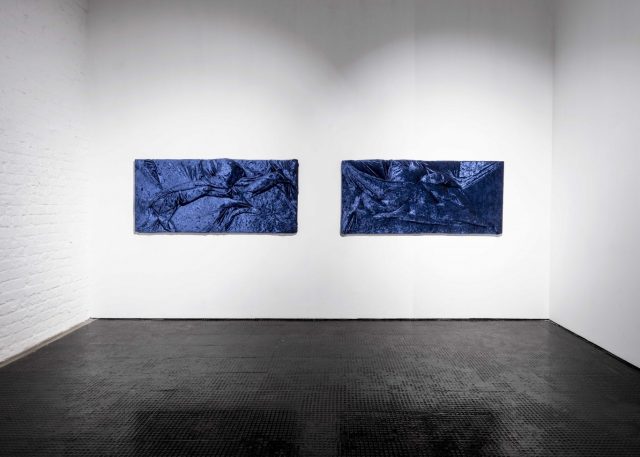I don’t recommend people work like I do,” Pittsburgh-based textile and installation artist Akudzwe Elsie Chiwa said. “I only stop when I get carpal tunnel. But I can make five works in a month. I work-binge.” When you look at Chiwa’s work, you can see how five in a month could give her carpal tunnel. She mixes velvet, silk, shells, tulle, found objects, beads, and even human hair to create artwork that defies definition. Her works are often huge and intricate. She spares no detail. Her vision and voice allow the material to speak for itself.
Akudzwe Elsie Chiwa’s Unique Understanding of Material
“My work is not just paintings or sculptures or textiles. It rejects the gaze. I make work based on my love for humanity, for women, for Black women. Even though it’s a love letter for Black women, the core story of it is humanism,” she said. “I want to ask people what it means to be human. Fabric is the most human material. Fabric is an object that views you. It’s the closest thing to your skin, your body. It covers you. It’s how you express yourself. It’s a watcher, from the first animal skin to the most velvety velvet, the height of luxury.”
Her interest in fabric has been lifelong, but it became suddenly real for her during a moment of profound loss at age sixteen. After her aunt died of HIV-AIDS, the second person in her family to do so, Chiwa’s grandmother wrapped her aunt in one of Chiwa’s sheets as a burial shroud. Chiwa observed the folds in the sheet as it covered her aunt’s body. “I felt both her absence and her peace,” Chiwa said. “My work began that day.”
Fabric Holds Both Beauty and Pain
Chiwa grew up in Zvishavane, an asbestos mining town in Zimbabwe, then studied in Cape Town, where she built her career through art fairs and commercial galleries across South Africa. She came to the United States with her partner, sculptor Parker Donaldson, a University of Cape Town graduate, in 2021. Chiwa’s first exhibition in America, Divinity/Femininity, debuted at the Pittsburgh Cultural Trust in 2023. But while living in Cape Town, she made a series of works inspired by how HIV-AIDS had affected her family.
That exhibition, Nocturnes, used dark, sensuous Italian velvet to convey both the pain and the beauty of loss. Chiwa’s handiwork brings intense emotion out of fabric. “I was thinking of wakes in Zimbabwe, where everyone sings the whole night. They tell stories, they comfort you. It’s very beautiful and surreal,” she said. Chiwa hand-stitched folds like those she saw in her aunt’s burial sheet over each frame. The work conveys the absence of a body through soft shapes in the velvet.

In Divinity/Femininity, she returned to that absent figure in the folds, but this time, she thought of the absence as her own. In a work titled Ndakuwona Mwanagu (I Have Seen You My Child) (2022), Chiwa tore up a mattress cushion and sewed haphazard fabric scraps into it to show her sense of living in a constant “in between” as an immigrant and having no consistent safety net in place. “A lot of what I make now is about that feeling of floating,” she said. “As an artist, you have to balance your work with your actual lived experience, and right now I’m in a transitional state.”

What’s Next for Akudzwe Elsie Chiwa
For Chiwa, fabric holds that space for transitional states and ambivalence. Much of her practice is inspired by what women pass onto each other, both the good and the bad. She thinks about how during her childhood, her mother worked abroad in England and would send her clothes. “I missed her so much, and sometimes, those clothes had her smell,” she said.
“I want to expand on this idea of a female holy trinity of the mother, the daughter, and the grandmother. I’d like to focus some more on sisterhood, too. I’ve made a lot about mothers and daughters, but not always so much about my two sisters.” She recently saw Raphael’s Three Graces in person for the first time and was moved by its depiction of sisterhood and divine femininity.
In upcoming projects, she plans to use cowhide to make a series based on how cows have been a form of currency in many African societies. “I’m looking at how cows are seen where I come from, and I’ve been learning to work with hide. It’s so hard!”
Chiwa found someone selling hide scraps on Amazon and has been sewing into those to build out this new project. It’s not lush Italian velvet, but, she said, “As an artist, you have to work with what you have.” She reflected that “These works do come from really traumatic moments in my life. But I choose to look at it not as this great ‘why me’ but instead ‘It had to be me.’ I can tell these stories. Trauma is how we learn as a species. How do we know fire burns and not to touch it? To be human is to exist with both joy and trauma.”
Story by Emma Riva / Photography courtesy of the Pittsburgh Cultural Trust and SMAC Gallery
 Subscribe to TABLE Magazine‘s print edition.
Subscribe to TABLE Magazine‘s print edition.

